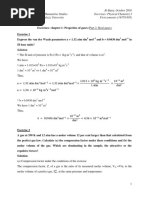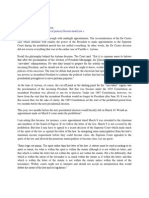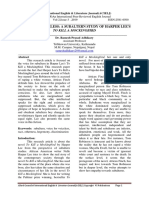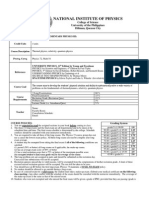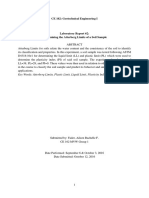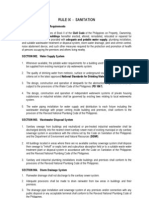Physics 73 Syllabus
Uploaded by
Aileen R. FaderPhysics 73 Syllabus
Uploaded by
Aileen R. FaderNATIONAL INSTITUTE OF PHYSICS
College of Science
University of the Philippines
Diliman, Quezon City
Course
PHYSICS 73 (ELEMENTARY PHYSICS III)
Credit Units
4 units
Course Description
Fundamentals of thermodynamics, relativity, quantum mechanics, and elementary particles
Prereq, Coreq
Physics 72, Math 54
References
UNIVERSITY PHYSICS, 11
th
Edition by Young and Freedman
PHYSICS for Scientist and Engineers, 4
th
Edition by Paul Tipler
PHYSICS, 5
th
Edition by David Halliday, Robert Resnick, and Kenneth Krane.
CONCEPTUAL PHYSICS, 8
th
Edition by Paul Hewitt
NONCLASSICAL PHYSICS: Beyond Newtons View by Randy Harris
Course Goal
The course aims to develop the students physical intuition and ability to systematically solve a wide variety of
problems on the fundamentals of thermodynamics, relativity, quantum mechanics, and elementary particles.
3 Long Examinations 60 %
Final Examination 20 %
Recitation Grade 10 %
Course
Requirements
Lecture Grade (i.e. Attendance/Quiz) 10 %
Teacher
Name:
Faculty Room:
Consultation Schedule:
Email:
UVLE Website http://uvle.upd.edu.ph (browse through the Physics 73 group)
COURSE POLICIES:
1. The three (3) long exams and the final exam are all departmental and to be taken at the
scheduled date and time. There is NO exemption in the final exam.
2. You should have an ID before the first long exam. Physics 73 maintains a NO ID NO
EXAM policy.
3. In case of one (1) missed long examfor a valid reason, the score that the student got for the
final exam will be used as the score for the missed long exam. (Submit your medical
certificate on the following class meeting.)
4. There is NO makeup for the final exam. A student who misses the final examwill be given a
grade of incomplete (INC) provided that (a) the student missed the examdue to a valid
reason, and (b) the students class standing excluding the final examis passing (i.e, pre-final
grade is 40% or better). If the student gets lower than 40%, automatically he/she gets a grade
of 5.0 [1]. Completion period is within one year. For completion, the student has to take the
final exam the next semester. Completion grade will be computed based on the class record
for the enrolled termand the final examscore. This means that a numerical grade of 1.0 to
5.0 is possible.
5. A grade of 4.0 means conditional and that you will have to take the removal examwithin a year.
6. As per university rule, a students absences should not exceed 12 meetings (recitation class included). If violated, the instructor will give
a zero lecture grade (i.e. zero out of 10%).
7. There is NO FORCED DROP. The lecturer will only give the student a grade of DRP upon receiving the processed dropping or Leave of
Absence (LOA) form. Otherwise, a grade of 5.0 is given.
8. The deadline for dropping is on September 6, 2007 (Thursday) and for filing LOA is on September 20, 2007 (Thursday). A student
granted an LOA will only be given a grade of either DRP or 5.0. A grade of 5.0 is given if the LOA is granted after of the semester
has lapsed and the student's class standing is failing; otherwise a grade of DRP is given.
9. Cheating is punishable by expulsion fromthe University.
Grading System
grade(%) 90.00 1.0
90.00 >grade(%) 85.00 1.25
85.00 >grade(%) 80.00 1.5
80.00 >grade(%) 75.00 1.75
75.00 >grade(%) 70.00 2.0
70.00 >grade(%) 65.00 2.25
65.00 >grade(%) 60.00 2.5
60.00 >grade(%) 55.00 2.75
55.00 >grade(%) 50.00 3.0
50.00 >grade(%) 45.00 4.0
45.00 >grade(%) 5.0
2
COURSE COVERAGE
CHAPTER 17: TEMPERATURE AND HEAT
Approx
Time
Objectives
After the discussion and lined up activities, you should be able to:
Topics
1 hour
Describe how temperature as a physical quantity is measured.
Explain what is thermal equilibriumand how it is determined physically.
Illustrate how the zeroth law is used to define temperature and design temperature scales.
Relate thermometric property with a temperature scales as well as the limitations of various
scales.
Mathematically and physically describe the relationship of various scales.
Zeroth Law of
Thermodynamics
Temperature
Measurement
1 hour
Describe a simple model for the linear and bulk expansion of objects upon absorption of heat.
Calculate for the expansion of solids due to changes in temperature.
Thermal Expansion
1 hour
Mathematically and physically describe what heat capacity is.
Solve for heat required/released for a system to change from one state to the other.
Heat and Heat Capacity
Calorimetry
1 hour
Enumerate and differentiate the three ways thermal energy may be transferred.
Describe emissivity and blackbodies.
Solve for heat current in conduction and radiation.
Mechanisms of Heat
Transfer
CHAPTER 18: THERMAL PROPERTIES OF MATTER
Approx
Time
Objectives
After the discussion and lined up activities, you should be able to:
Topics
2 hours
Define what a thermodynamic state is in relation to equilibrium.
Explain the significance of a quasi-static process.
Differentiate between the macro- and microstates.
Describe what an ideal gas is (i.e. enumerate its properties and provide the defining equation of
state).
Compute for a thermodynamic variable given others quantities.
Describe a more realistic model of gas.
Cite consequences of Van der Waals equation in the properties of the gas.
Equations of State
Ideal Gas equation
Van der Waals equation
(reading assignment)
1 hour
Account for the microscopic origins of the various thermodynamic variables.
Enumerate the assumptions of kinetic model of an ideal gas.
Mathematically relate macroscopic variables of an ideal gas with microscopic ones.
Kinetic Theory of
Gases
1 hour
Differentiate the heat capacities of an ideal gas for the various processes.
Illustrate how the heat capacity of a solid is calculated using the equipartition theorem.
Discuss failure of equipartition theorem.
Heat Capacity of Gases
Dulong-Petit Law
Phases of Matter
(reading assignment)
3
Calculate for the internal energy of an ideal gas using the equipartition theorem.
Discuss significance and limitation of equipartition theorem.
Illustrate the use of phase diagrams to describe physical state of substances.
CHAPTER 19: THE FIRST LAW OF THERMODYNAMICS
Approx
Time
Objectives
After the discussion and lined up activities, you should be able to:
Topics
1 hour
Define a thermodynamic systemfor a given physical set-up and describe the type of boundary.
Identify the system-environment interactions from the boundary.
Interpret PV diagrams of a thermodynamic process.
Compute the work done using PV diagrams.
Thermodynamic
Systems
Work Done During
Volume Changes
2 hours
Explain mathematical and physical significance of internal energy as a state function.
Solve for thermodynamic quantities using the conservation of energy.
Differentiate the following basic thermodynamic processes: isochoric, isobaric, isothermal,
adiabatic and a cyclic process.
Write down the first law equations for the said processes.
Differentiate heat capacities of an ideal gas for various processes.
Solve for the change in internal energy, work and heat transferred for the said processes.
Solve for the thermodynamic variables of one state given the thermodynamic variables of
another state.
First Law of
Thermodynamics
Internal Energy as State
Function
Thermodynamic
Processes
Internal Energy of an
Ideal Gas
CHAPTER 20: THE SECOND LAW OF THERMODYNAMICS
Approx
Time
Objectives
After the discussion and lined up activities, you should be able to:
Topics
1 hour
Describe the operation of an actual engine (esp. Otto engine).
Develop and describe a cyclic process (esp. the Otto process) representing such an engine.
Illustrate per cycle operation of an engine using the Energy Reservoir Model (ERM).
Solve for the efficiency of a heat engine.
Calculate for the power generated and various thermodynamic quantities in a given engine cycle
(esp. Otto cycle).
Discuss impossibility of developing a perpetual heat engine.
Heat Engines
Engine Cycles
1 hour
Describe the operation of a refrigerator.
Illustrate the ERM of a refrigerator.
Solve for the coefficient of performance of a refrigerator.
Solve problems relating heat engine with refrigerator.
Refrigerator
1 hour
State the Kelvin and Clausius statements and explain the physical motivation for such
statements.
Use the statements to explain certain physical phenomena.
State the Heat engine form of the 2
nd
law and illustrate meaning using ERM and efficiency.
State the Refrigerator form of the 2
nd
law and illustrate meaning using COP and efficiency.
Second Law of
Thermodynamics
4
1 hour
Enumerate conditions necessary for a reversible process to take place.
Develop an equivalent reversible process for a given irreversible process.
Illustrate irreversibility in natural processes.
Describe the Carnot cycle (enumerate the processes consisting the cycle as well as illustrate the
cycle on a PV diagram).
State Carnots theoremand use it to calculate maximum possible efficiency of a real engine.
Explain how reversible cycles are used to design a substance-independent thermometer scale.
Reversible and
Irreversible Processes
Carnot Cycle
2 hours
Mathematically describe entropy for reversible processes and cite consequences of entropy
being a state function.
Solve for entropy changes for various processes: isothermal process, free expansion, inelastic
collision, constant pressure process, heat conduction, Carnot cycle
State 2
nd
Law in terms of entropy of the universe and explain significance for naturally
occurring processes.
Differentiate useful from useless forms of energy. Calculate for amount of lost work using
change in entropy.
Differentiate macroscopic frommicroscopic interpretation of entropy and illustrate their
equivalence as well as use in explaining various physical phenomena.
Describe order and disorder in terms of the number of available (i.e. accessible) microstates
for a given macrostate.
Entropy
Useful Work
Order and Disorder
FIRST EXAMINATION July 25 (W) 9-11 am
CHAPTER 37: RELATIVITY
Approx
Time
Objectives
After the discussion and lined up activities, you should be able to:
Topics
1 hour
Define an inertial reference frame.
State the Principle of Newtonian Relativity.
Explain the implications of Einsteins Postulates.
Newtonian Relativity
Einsteins Postulates
1 hour
Define an event and describe how measurements are taken in an inertial frame.
Define the interval and differentiate it fromthe Euclidean notion of distance.
Relate measurements of an event in one inertial frame with another inertial frame.
Events and
Measurements
Invariance of the
Interval
1 hour
Draw the space-time axis of a given inertial frame and the world lines of all events relative to
this inertial frame.
Interpret physical meaning of space-time diagrams.
Relate geometric measurements with relativistic concepts.
World Lines and
Spacetime Diagrams
1 hour
Describe synchronization of two clocks relative to inertial observers.
Clock Synchronization
and Simultaneity
1 hour
Given a physical situation involving relativistic motion, apply Lorentz velocity transformation
Velocity
Transformation
5
to draw qualitative and quantitative conclusions regarding the velocities relative to inertial
reference frames.
2 hours
Relate Galilean and Lorentz transformations with the Einsteins Postulates.
Given a physical situation involving relativistic motion, apply definitions of proper time and
proper length to draw qualitative and quantitative conclusions regarding the length, time
interval and relative velocities.
Lorentz Transformation
Time Dilation
Length Contraction
1 hour
Given a physical situation involving relativistic motion, apply relativistic Doppler effect to draw
qualitative and quantitative conclusions regarding frequency and velocity.
Relativistic Doppler
Effect
2 hours
Calculate the relativistic momentum and total energy of a particle given its rest mass and speed.
Determine the velocity and rest energy of a systemafter an inelastic collision.
Explain the consequences of Einsteins General Relativity.
Relativistic Momentum
Relativistic Work and
Energy
General Relativity
SECOND EXAMINATION August 22 (W) 9-11 am
CHAPTER 38: PHOTON, ELECTRONS, AND ATOMS
Approx
Time
Objectives
After the discussion and lined up activities, you should be able to:
Topics
2 hours
Discuss aspects of the photoelectric effect.
Solve for either maximum kinetic energy of the emitted electrons, work function or threshold
frequency once the other two are known.
Solve for the energy of a quanta of light given its frequency and vice-versa.
Solve for the momentumof light given its wavelength and vice-versa.
Solve for scattering wavelength of light when it collides with matter.
Photoelectric Effect
Quantization of Light
Compton Scattering
1 hour
Discuss the failure of some classical models of the atom.
Enumerate the postulates in Bohrs model of the atom.
Show how the Bohr model successfully accounted for the observed discrete spectral lines as
well as the Rydberg-Ritz relation.
Bohr Model
CHAPTER 39: THE WAVE NATURE OF PARTICLES
2 hours
Discuss the significance of the de Broglie Hypothesis
Solve for the wavelength of a particle given its momentumor kinetic energy.
Elaborate on the duality of matter and light and know when one aspect is more useful in
explaining observed phenomena.
State the uncertainty principle and be able to estimate uncertainties in experiments.
de Broglie Waves
Wave-Particle Duality
Probability and
Uncertainty
3 hours
Explain what a wave function is and illustrate its significance in determining all physically
measurable quantities in a quantumsystem.
Solve for the probability of occurrence of a classical event.
Solve for the mean and variance of some classical distributions.
Wave Function
Probability and
Normalization
6
Solve for the expectation value of some measurables (esp. position and variance) given the
wave function of a quantum system.
Expectation Values
Schrodinger Equation
CHAPTER 40: QUANTUM MECHANICS
Approx
Time
Objectives
After the discussion and lined up activities, you should be able to:
Topics
3 hours
Illustrate how the wavefunction of a system may be derived using the Schrdingers Equation
for the following systems: Free Particle, Infinite Well, Finite Well, Harmonic Oscillator, and
Coulombic Potential.
Differentiate the wavefunctions of the systems mentioned above.
Enumerate the properties of a physically realizable wavefunction.
Show how bound quantum systems have quantized energy levels and solve for the ground state
energy.
Draw and interpret probability density plots.
Deduce the most probable values of dynamical variables from the probability density plot.
Applications of
Schrdinger Equation
Energy Quantization
Wave Function and the
Probability Density
1 hour
Discuss differences in quantum and classical predictions of some unbound systems.
Calculate for the probability of transmitting a quantum particle into classically forbidden
regions.
Discuss how the different physical parameters affect the probability of transmission.
Potential Barrier and
Tunneling
1 hour
Show how degeneracy arises in quantumsystems of more than one dimension.
Generate the possible quantumstates of a systemby listing down the corresponding quantum
numbers.
Solve for the energy levels and determine which ones are degenerate.
Schrdingers Equation
in Three Dimensions
CHAPTER 41: ATOMIC STRUCTURE
3 hours
Show how the indistinguishability of two quantumparticles leads to two types of
wavefunctions.
State Paulis exclusion principle and explain how it is exhibited in physical systems.
Two Identical Particles
Hydrogen Atom
Zeeman Effect
THIRD EXAMINATION October 3 (W) 9-11 am
PHYSICS PALS:
NAME EMAIL PHONE MOBILE
1.
2.
3.
4.
5.
You might also like
- Hourglass Workout Program by Luisagiuliet 276% (21)Hourglass Workout Program by Luisagiuliet 251 pages
- The Hold Me Tight Workbook - Dr. Sue Johnson100% (16)The Hold Me Tight Workbook - Dr. Sue Johnson187 pages
- Read People Like A Book by Patrick King-Edited62% (65)Read People Like A Book by Patrick King-Edited12 pages
- Livingood, Blake - Livingood Daily Your 21-Day Guide To Experience Real Health77% (13)Livingood, Blake - Livingood Daily Your 21-Day Guide To Experience Real Health260 pages
- COSMIC CONSCIOUSNESS OF HUMANITY - PROBLEMS OF NEW COSMOGONY (V.P.Kaznacheev,. Л. V. Trofimov.)94% (212)COSMIC CONSCIOUSNESS OF HUMANITY - PROBLEMS OF NEW COSMOGONY (V.P.Kaznacheev,. Л. V. Trofimov.)212 pages
- Donald Trump & Jeffrey Epstein Rape Lawsuit and Affidavits83% (1016)Donald Trump & Jeffrey Epstein Rape Lawsuit and Affidavits13 pages
- The 36 Questions That Lead To Love - The New York Times94% (34)The 36 Questions That Lead To Love - The New York Times3 pages
- The 36 Questions That Lead To Love - The New York Times95% (21)The 36 Questions That Lead To Love - The New York Times3 pages
- Jeffrey Epstein39s Little Black Book Unredacted PDF75% (12)Jeffrey Epstein39s Little Black Book Unredacted PDF95 pages
- The 4 Hour Workweek, Expanded and Updated by Timothy Ferriss - Excerpt23% (954)The 4 Hour Workweek, Expanded and Updated by Timothy Ferriss - Excerpt38 pages
- Sample First Long Exam (Chem 17) : CHEM 17 (2 Sem, AY 15 - 16) UP ACME - Page 1 of 5No ratings yetSample First Long Exam (Chem 17) : CHEM 17 (2 Sem, AY 15 - 16) UP ACME - Page 1 of 55 pages
- College of Science University of The Philippines Department of Physical Sciences Discipline of ChemistryNo ratings yetCollege of Science University of The Philippines Department of Physical Sciences Discipline of Chemistry2 pages
- Extraction and Isolation of Proteins Protein Quantitation Through Spectrophotometric Methods Background of The ExperimentNo ratings yetExtraction and Isolation of Proteins Protein Quantitation Through Spectrophotometric Methods Background of The Experiment6 pages
- I. Multiple Choice. Write The Best Answer From The Following Choices100% (2)I. Multiple Choice. Write The Best Answer From The Following Choices5 pages
- Chem Mole Calculations Multiple Choice 2013-04-03No ratings yetChem Mole Calculations Multiple Choice 2013-04-0315 pages
- Monitoring Protein Conformational Changes by Viscosity and Cd-Spectroscopy Background of The ExperimentNo ratings yetMonitoring Protein Conformational Changes by Viscosity and Cd-Spectroscopy Background of The Experiment6 pages
- TOS PRB-ChE Resolution 3.2023 With AnnexNo ratings yetTOS PRB-ChE Resolution 3.2023 With Annex17 pages
- Chem 332b/L Physical Chemistry For Chemical: Engineers 1No ratings yetChem 332b/L Physical Chemistry For Chemical: Engineers 135 pages
- Summary of IUPAC Nomenclature of Organic Compounds100% (1)Summary of IUPAC Nomenclature of Organic Compounds9 pages
- MMME 21 Remote Learning Syllabus AY 20-21No ratings yetMMME 21 Remote Learning Syllabus AY 20-217 pages
- Velasco Cases - Civil Law - Dean Mawis PDFNo ratings yetVelasco Cases - Civil Law - Dean Mawis PDF9 pages
- Chem 16 2nd Long Exam Reviewer 2 (Answer Key)No ratings yetChem 16 2nd Long Exam Reviewer 2 (Answer Key)2 pages
- Chemical Technicians 11-2023 - List of Qualified ExamineesNo ratings yetChemical Technicians 11-2023 - List of Qualified Examinees22 pages
- Adsorptionfromsolutionsaceticacidoncharcoal 120930023324 Phpapp01No ratings yetAdsorptionfromsolutionsaceticacidoncharcoal 120930023324 Phpapp017 pages
- Comparative Investigation of Organic CompoundsNo ratings yetComparative Investigation of Organic Compounds5 pages
- Quantitative Determination of Soda Ash Composition by Double Indicator TitrationNo ratings yetQuantitative Determination of Soda Ash Composition by Double Indicator Titration3 pages
- National Institute of CHHH: College of Science University of The Philippines Diliman, Quezon CityNo ratings yetNational Institute of CHHH: College of Science University of The Philippines Diliman, Quezon City11 pages
- National Institute of Chemistry: College of Science University of The Philippines Diliman, Quezon CityNo ratings yetNational Institute of Chemistry: College of Science University of The Philippines Diliman, Quezon City11 pages
- National Institute of Physics: College of Science University of The Philippines Diliman, Quezon CityNo ratings yetNational Institute of Physics: College of Science University of The Philippines Diliman, Quezon City10 pages
- CE162 Lab Report Abstract Atterberg LimitsNo ratings yetCE162 Lab Report Abstract Atterberg Limits1 page
- Rule IX Sanitation, National Building Code, Philippines100% (3)Rule IX Sanitation, National Building Code, Philippines2 pages
- Livingood, Blake - Livingood Daily Your 21-Day Guide To Experience Real HealthLivingood, Blake - Livingood Daily Your 21-Day Guide To Experience Real Health
- COSMIC CONSCIOUSNESS OF HUMANITY - PROBLEMS OF NEW COSMOGONY (V.P.Kaznacheev,. Л. V. Trofimov.)COSMIC CONSCIOUSNESS OF HUMANITY - PROBLEMS OF NEW COSMOGONY (V.P.Kaznacheev,. Л. V. Trofimov.)
- Donald Trump & Jeffrey Epstein Rape Lawsuit and AffidavitsDonald Trump & Jeffrey Epstein Rape Lawsuit and Affidavits
- The 36 Questions That Lead To Love - The New York TimesThe 36 Questions That Lead To Love - The New York Times
- The 36 Questions That Lead To Love - The New York TimesThe 36 Questions That Lead To Love - The New York Times
- Jeffrey Epstein39s Little Black Book Unredacted PDFJeffrey Epstein39s Little Black Book Unredacted PDF
- The 4 Hour Workweek, Expanded and Updated by Timothy Ferriss - ExcerptThe 4 Hour Workweek, Expanded and Updated by Timothy Ferriss - Excerpt
- Sample First Long Exam (Chem 17) : CHEM 17 (2 Sem, AY 15 - 16) UP ACME - Page 1 of 5Sample First Long Exam (Chem 17) : CHEM 17 (2 Sem, AY 15 - 16) UP ACME - Page 1 of 5
- College of Science University of The Philippines Department of Physical Sciences Discipline of ChemistryCollege of Science University of The Philippines Department of Physical Sciences Discipline of Chemistry
- Extraction and Isolation of Proteins Protein Quantitation Through Spectrophotometric Methods Background of The ExperimentExtraction and Isolation of Proteins Protein Quantitation Through Spectrophotometric Methods Background of The Experiment
- I. Multiple Choice. Write The Best Answer From The Following ChoicesI. Multiple Choice. Write The Best Answer From The Following Choices
- Monitoring Protein Conformational Changes by Viscosity and Cd-Spectroscopy Background of The ExperimentMonitoring Protein Conformational Changes by Viscosity and Cd-Spectroscopy Background of The Experiment
- Chem 332b/L Physical Chemistry For Chemical: Engineers 1Chem 332b/L Physical Chemistry For Chemical: Engineers 1
- Summary of IUPAC Nomenclature of Organic CompoundsSummary of IUPAC Nomenclature of Organic Compounds
- Chemical Technicians 11-2023 - List of Qualified ExamineesChemical Technicians 11-2023 - List of Qualified Examinees
- Adsorptionfromsolutionsaceticacidoncharcoal 120930023324 Phpapp01Adsorptionfromsolutionsaceticacidoncharcoal 120930023324 Phpapp01
- Quantitative Determination of Soda Ash Composition by Double Indicator TitrationQuantitative Determination of Soda Ash Composition by Double Indicator Titration
- National Institute of CHHH: College of Science University of The Philippines Diliman, Quezon CityNational Institute of CHHH: College of Science University of The Philippines Diliman, Quezon City
- National Institute of Chemistry: College of Science University of The Philippines Diliman, Quezon CityNational Institute of Chemistry: College of Science University of The Philippines Diliman, Quezon City
- National Institute of Physics: College of Science University of The Philippines Diliman, Quezon CityNational Institute of Physics: College of Science University of The Philippines Diliman, Quezon City
- Rule IX Sanitation, National Building Code, PhilippinesRule IX Sanitation, National Building Code, Philippines






















































